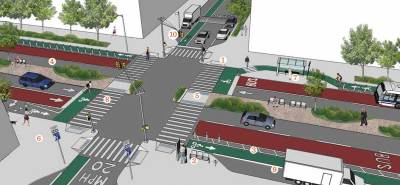TA: De Blasio Must Undo Construction Budget Cuts to Fix Dangerous Streets

Arterial streets — the city’s big, busy, highway-like roadways — cover just 15 percent of the New York City street network but account for nearly 60 percent of all pedestrian fatalities. The city will have to overhaul these streets to achieve Mayor de Blasio’s Vision Zero goals. And to make those changes, the city must reverse cuts to its roadway reconstruction budget, according to a new report from Transportation Alternatives [PDF].

Earlier this month, DOT announced that it will be committing $250 million to multi-year overhauls of Queens Boulevard, Fourth Avenue, Atlantic Avenue, and the Grand Concourse. TA urges the city to make that announcement a downpayment, not the final number. The report estimates that as many as 50 lives could be saved and 1,200 serious pedestrian injuries could be avoided each year if DOT redesigns all major arterial streets for safety.
At the city’s current rate of investment, however, it will take more than 100 years to fix the city’s arterial streets, TA says. The group estimates that Mayor Bill de Blasio’s preliminary budget drops funding for road reconstruction from an average of 47 lane-miles each year to 35 lane-miles each year. TA is asking the city to double its commitment, to $2.4 billion over 10 years. This would also ensure that streets do not fall into disrepair for decades before there is funding to rebuild them again.
In addition to more funding, TA recommends setting specific benchmarks and accelerating the timetable for implementation, with groundbreaking on the first arterial reconstructions by 2017 and a fast-tracked delivery plan. (Transportation Commissioner Trottenberg made promises to that effect earlier this month.)
Smaller projects that add curb extensions and road diets to targeted locations can have a big impact even without a complete road reconstruction. DOT has promised to complete 50 of these projects a year. TA is asking for an additional $50 million annually from the city budget to cover more ground in a shorter amount of time.
The report also recommends greater clarity from DOT about where it is looking to install safety improvements, and what changes will be pursued. That way, the public can ensure the agency’s plans align with the locations DOT identified in pedestrian safety action plans for each borough. Those plans identified 443 miles of dangerous corridors in need of safety overhauls.
Why is it important to fix the city’s arterial streets? In addition to making the city safer and less stressful for everybody, the implications are especially significant for New York’s most vulnerable residents. Studies show that low-income communities, seniors, and children are disproportionately affected by traffic violence.
There will also be fiscal and economic payoffs. Traffic claims involving government vehicles cost city taxpayers $91.2 million in 2013. In total, traffic crashes cost the city’s economy approximately $3.9 billion each year, according to the National Highway Traffic Safety Administration, and have total annual costs of more than $12 billion, including life lost and chronic disability.

The report singles out one arterial in each borough to illustrate the scale of changes the city should pursue: Queens Boulevard, Atlantic Avenue, the Grand Concourse, Hylan Boulevard, and Sixth Avenue in Manhattan. The city has embarked on safety overhauls for some of these streets, but the improvements can’t come soon enough. Since July 2012, 45 people were killed and 6,120 were injured on these five streets, according to TA.
The designs DOT chooses will be critical. TA’s renderings show how wider sidewalks and crosswalks, pedestrian refuges, protected bike lanes, dedicated bus lanes, and narrower car lanes can contribute to greater safety on major streets.
This post’s third paragraph has been updated to accurately characterize TA’s analysis of the mayor’s preliminary budget.
